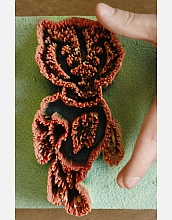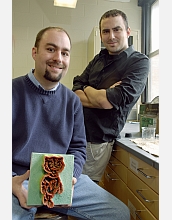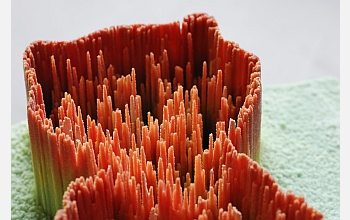All Images
News Release 07-034
Getting a Feel for the Nano World
New models help introduce the blind to careers in nanoscale science and engineering
This material is available primarily for archival purposes. Telephone numbers or other contact information may be out of date; please see current contact information at media contacts.

An enlarged, 3-D model of "NanoBucky," a nanoscale version of the University of Wisconsin-Madison mascot Bucky Badger, is made entirely from tiny carbon nanofiber "hairs." To create the 3-D model, Mohammed Farhoud, a UW-Madison senior in biochemistry, converted the 2-D information contained in a scanning electron microscopy image of the original NanoBucky into 3-D, and then used these data to "print" the model in plaster with an engineering tool known as a rapid prototyping printer. The 3-D version is tens of thousands of times larger than the original NanoBucky--9,000 of which can fit on the head of a pin--but still faithfully replicates the nanofibers composing the nano-mascot's structure. This image is restricted and not for general use. Please see instructions at the bottom of the university image page for additional information: http://www.news.wisc.edu/newsphotos/nanobucky07.html
Credit: Aaron Mayes
Download the high-resolution JPG version of the image. (1.9 MB)
Use your mouse to right-click (Mac users may need to Ctrl-click) the link above and choose the option that will save the file or target to your computer.

From left, Andrew Greenberg, education and outreach coordinator for NSF's Nanoscale Science and Engineering Center (NSEC) at the University of Wisconsin-Madison, and Mohammed Farhoud, a UW-Madison senior in biochemistry, pose with their enlarged, 3-D model of the nanoscale structure "NanoBucky." By giving blind and visually impaired students a chance to explore nanoscale surfaces with their hands, Greenberg hopes the models will help these students grasp nanoscience concepts and entice more of them to pursue science, technology and engineering. This image is restricted and not for general use. Please see instructions at the bottom of the university image page for additional information: http://www.news.wisc.edu/newsphotos/nanobucky07.html
Credit: Aaron Mayes
Download the high-resolution JPG version of the image. (2 MB)
Use your mouse to right-click (Mac users may need to Ctrl-click) the link above and choose the option that will save the file or target to your computer.

A close-up of the 3-D, plaster model of "NanoBucky" showing the individual carbon nanofibers that the structure is built from. Researcher Andrew Greenberg, education and outreach coordinator for NSF's Nanoscale Science and Engineering Center at the University of Wisconsin-Madison, and Mohammed Farhoud, a UW-Madison senior in biochemistry, are constructing models to allow visually impaired students to feel the nanofibers, teaching these students about nanosurfaces and the construction of nanostructures. This image is restricted and not for general use. Please see instructions at the bottom of the university image page for additional information: http://www.news.wisc.edu/newsphotos/nanobucky07.html
Credit: Aaron Mayes
Download the high-resolution JPG version of the image. (1.4 MB)
Use your mouse to right-click (Mac users may need to Ctrl-click) the link above and choose the option that will save the file or target to your computer.
